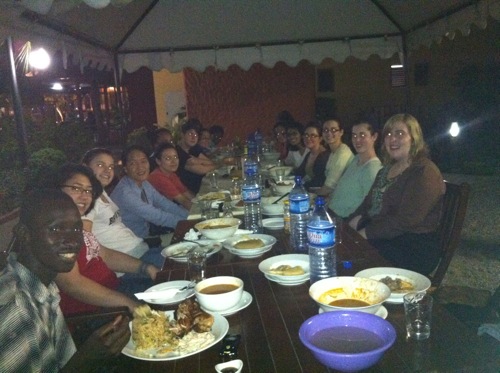Serendip is an independent site partnering with faculty at multiple colleges and universities around the world. Happy exploring!
Blogs
Friday evening in Accra
We enjoyed delicious stews and fufu al fresco at our hotel. A recent BMC alum from and now living here stopped by to day hello! The air and breezes are soft.

Female Genital Mutilation
Rebecca Sheriff
Female Genital Mutilation

Female genital mutilation (FGM), also known as female genital cutting is a
practice that has been going on for thousands of years based in northern Africa, the
Middle East, and parts of south Asia. Although there are claims that FMG is done for
religious reasons, there are no passages in the Koran, Bible, or Torah supporting FGM.
Because FGM has no health benefits, but instead serious health risks, including death, the
World Health Organization (WHO), Human Rights Watch, and countless other
organizations are trying to put an end to it. Many countries including western nations that
have immigrants from the main countries of FGM , have made FGM illegal. Several
politicians and activists have proposed implementing mandatory gynecological exams in
elementary schools for at risk students, but this has been rejected. The governments of
these countries who have outlawed FGM are working with many organizations like
UNICEF, Amnesty International, and WHO to take preventative measures, which mainly
consist of spreading education on the affects of FGM.
Female genital mutilation is classified into four groups. Type 1 is the excision of
the clitoral hood, usually as well as the clitoris. Type 2 is the excision of the clitoris and
In the defense of language
The 1970s saw the emergence of a new form of feminism in France, known as l’ecriture feminine, or the writing of women. This form was introduced by French feminists such as Monique Wittig, Luce Irigaray, Hélène Cixous and Julia Kristeva, among others[1]. These influential writers and feminists asserted that traditional writing centered on the male experience and was therefore phallocentric. This phallocentricity essentially either forced women to view the world through a male perspective in their language use, or subjugated them to silence[2]. The introduction of l‘ecriture feminine’ was meant to give a voice to the female experience and allow women to express their unique, non-male experiences and selves. As society has marginalized women and their experiences, language has been used as a tool of institutionalized oppression and even furthered it[3]. However, language in itself is an organic, and even inherently feminist form of communication.

just speak nearby/working towards ideas
Initially, I thought about feminism across different geographic locations as global feminism, as a feminism rooted in nations, defined and given flavor by the nation as a whole. That is, thinking about American feminism and Indian feminism and Ghanaian feminism and French Feminism. But then, that is SO American-centric of me. When I try to think of a certain American feminism, it’s impossible. Just to think of Bryn Mawr feminism strikes me as impossible. And I’m not trying to suggest that we’re all special feminist snowflakes, or that there is not sense of shared feminist thought or identity. But our shorthand, our labeling of feminisms as rooted in some national identity/location/region can have the possibility of flattening and erasing nuance from how feminists express themselves in a variety of contexts.
The Discourse of Knowledge: An Exploration of the Evolving Genre of Education
“Learning is like a vending machine,” my father used to tell me, “You get out of it however much you put in.” The equation seemed easy enough. A student goes to class, sits in a chair and listens as the teacher speaks for a given amount of time, and by putting in the effort of listening and paying attention, she learns the concepts the teacher is trying to teach. This process seemed to fit the equation, seemed to be effective enough. After all, there is no other way that society has ever learned. For hundreds of years, we have been learning through a hierarchical structure, one in which there are set roles for teacher and student, and no movement in between the two.

Is There Room for Feminism in Global Economics?

Watch Who’s Counting?: Marilyn Waring on Sex, Lies, and Economics Here :
http://www.nfb.ca/film/whos_counting
At the spectacle of rapidly expanding, nation interlacing sphere of globalism, the concept of an inclusive worldwide economy hardly seems like a digestible one. According to Marilyn Waring, however, because it specifically seeks not to be.
About Waring— 
Greetings from Accra

We arrived after a delayed but easy flight to be met by our local guides. A taxi ride through the city to our comfortable hotel. Sights, sounds, and smiles too many/much to set down right now. This group is traveling beautifully! Paying games in the dc airport and taking turns writing and drawing in our group scrapbook are two standouts. We are freshening up before we go out to dinner together. Tomorrow we ride the bus North. Amazed and grateful, Alice


Feminism in SlutWalk

Feminism of SlutWalk
SlutWalk is a protest event that began in April of 2011 in Toronto to express freedom of expression and anger at double standards. It has since expanded to other cities including New York and Chicago. SlutWalk Toronto was originally spurred by a Toronto police officer who suggested that “women should avoid dressing like sluts in order not to be victimized.” This made a lot of people angry.
SlutWalk Toronto’s website explains that this statement is wrong and hurtful for many reasons. Sexual assault is a serious crime and has nothing to do with the clothing a woman wears. No woman is “asking for it” when she wears a blouse that shows cleavage or when she wears sky-high platform pumps. By placing blame on the victim, it makes her less likely to report it to authorities or seek professional help.

Taking a Different Road: How Does Form Change Content?
In Understanding Comics, Scott McCloud makes a point to distinguish form from content. Comics have been traditionally thought of as superhero picture books for an immature audience. More recently, however, comics have grown up. Much as a child might transition from being called Jimmy to James as an adult, now the comic is the graphic novel and its form is being utilized address more serious themes. But what is the effect? How does this format alter the content or the way in which we interpret the material?
A new space:
One of the outcomes derives from the stereotype of comics themselves. To take a very serious issue of a country and its people in turmoil, as Satrapi does in Persepolis, and place it in a historically child-like format alters the space in which our perceptions and interpretations of the novel are formed. It invites the reader into the more basic level of reasoning that we used as children, an exploration of content from a different but formerly familiar place. In the same way that you might reminisce about your younger days when visiting your old elementary school, maybe we are being asked to reminisce about the way we used to think about the world when we’re placed in this youthful space versus the space in a very adult-like piece of literature.

The Classroom as an Evolving Genre
Genres allow us to communicate with each other and challenge our thoughts. Genres have been emerging and evolving because of sociological and psychological aspects. Classrooms can be considered a genre of their own due to the fact they are in constant evolution but they are a genre within the genre that is schools. The genre of classrooms branches out to the evolution of our thoughts and the evolution of the classroom as a learning space and the technology that enriches our experience. For the longest time, classrooms have been defined as enclosed spaces where students go to learn. It is a collaborative effort between students and professors to make classrooms a safe and confortable environment that inspires students to disagree without launching personal attacks, stereotyping, judging, and encourages and expects everyone to respectfully disagree without disagreeing with you as a whole. Students often bring their own experiences and expectations on what they would like to learn. The classroom is constantly evolving as a genre because vigorous discussions encourage us students to challenge each other’s opinions for the sake of better understanding of the lessons at hand as well as the world outside the classroom.


